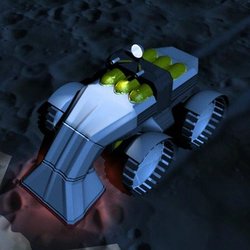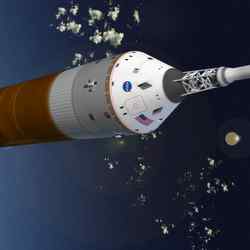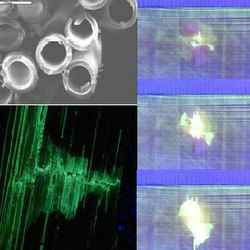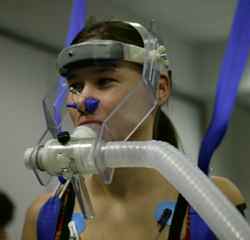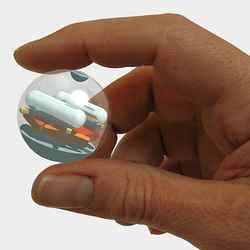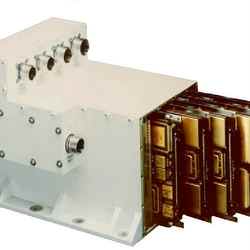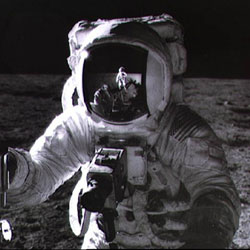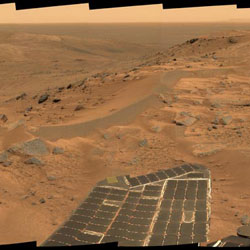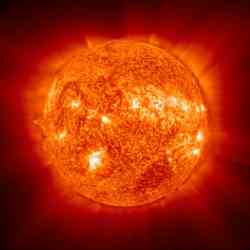
The sun is a major source of radiation for life on Earth. Image credit: NASA/ESA/SOHO. Click to enlarge
Space travel has its dangers. One of the biggest risks will come from the various types of radiation that flood space. Scientists are learning how life on Earth has evolved different kinds of tricks to resist radiation. Some animals and plants have evolved protective covering or pigmentation, but some forms of bacteria can actually repair damage to its DNA from radiation. Future space travelers might take advantage of these techniques to minimize the harm they get from long exposure.
In Star Wars and Star Trek movies, people travel between planets and galaxies with ease. But our future in space is far from assured. Issues of hyperdrive and wormholes aside, it doesn’t seem possible that the human body could withstand extended exposure to the harsh radiation of outer space.
Radiation comes from many sources. Light from the sun produces a range of wavelengths from long-wave infrared to short-wavelength ultraviolet (UV). Background radiation in space is composed of high-energy X-rays, gamma rays and cosmic rays, which all can play havoc with the cells in our bodies. Since such ionizing radiation easily penetrates spacecraft walls and spacesuits, astronauts today must limit their time in space. But being in outer space for even a short time greatly increases their odds of developing cancer, cataracts, and other radiation-related health problems.
To overcome this problem, we may find some useful tips in nature. Many organisms already have devised effective strategies to protect themselves from radiation.
Lynn Rothschild of the NASA Ames Research Center says that radiation has always been a danger for life on Earth, and so life had to find ways to cope with it. This was especially important during the Earth’s earliest years, when the ingredients for life were first coming together. Because our planet did not initially have much oxygen in the atmosphere, it also lacked an ozone (O3) layer to block out harmful radiation. This is one reason why many believe life originated underwater, since water can filter out the more damaging wavelengths of light.
Yet photosynthesis ? the transformation of sunlight into chemical energy ? developed relatively early in the history of life. Photosynthetic microbes like cyanobacteria were using sunlight to make food as early as 2.8 billion years ago (and possibly even earlier).
Early life therefore engaged in a delicate balancing act, learning how to use radiation for energy while protecting itself from the damage that radiation could cause. While sunlight is not as energetic as X-rays or gamma rays, the UV wavelengths are preferentially absorbed by DNA bases and by the aromatic amino acids of proteins. This absorption can damage cells and the delicate DNA strands that encode the instructions for life.
“The problem is, if you’re going to access solar radiation for photosynthesis, you’ve got to take the good with the bad — you’re also exposing yourself to the ultraviolet radiation,” says Rothschild. “So there’s various tricks that we think early life used, as life does today.”
Besides hiding under liquid water, life makes use of other natural UV radiation barriers such as ice, sand, rocks, and salt. As organisms continued to evolve, some were able to develop their own protective barriers such as pigmentation or a tough outer shell.
Thanks to photosynthetic organisms filling the atmosphere with oxygen (and thereby generating an ozone layer), most organisms on Earth today don’t need to contend with high energy UV-C rays, X-rays or gamma rays from space. In fact, the only organisms known to survive space exposure ? at least in the short term – are bacteria and lichen. Bacteria need some shielding so they won’t get fried by the UV, but lichen have enough biomass to act as a protective spacesuit.
But even with a good barrier in place, sometimes radiation damage does occur. The lichen and bacteria hibernate while in space ? they do not grow, reproduce, or engage in any of their normal living functions. Upon return to Earth, they exit this dormant state and, if there was damage inflicted, proteins in the cell work to piece together DNA strands that were broken apart by radiation.
The same damage control occurs with organisms on Earth when they’re exposed to radioactive materials such as uranium and radium. The bacterium Deinococcus radiodurans is the reigning champion when it comes to this sort of radiation repair. (Complete repair is not always possible, however, which is why radiation exposure can lead to genetic mutations or death.)
“I live in eternal hope of unseating D. radiodurans,” says Rothchild. Her search for radiation-resistant microorganisms has brought her to Paralana hot spring in Australia. Uranium-rich granite rocks emit gamma rays while lethal radon gas bubbles up from the hot water. Life in the spring is therefore exposed to high levels of radiation ? both below, from the radioactive materials, and above, from the intense UV light of the Australian sun.
Rothschild learned about the hot spring from Roberto Anitori of Macquarie University’s Australian Centre for Astrobiology. Anitori has been sequencing the 16S ribosomal RNA genes and culturing the bacteria that live quite happily in the radioactive waters. Like other organisms on Earth, the Paralana cyanobacteria and other microbes may have devised barriers to shield themselves from the radiation.
“I have noticed a tough, almost silicone-like layer on some of the microbial mats there,” says Anitori. “And when I say “silicon-like,” I mean the sort you use on window pane edging.”
“Apart from possible shielding mechanisms, I suspect that the microbes at Paralana also have good DNA repair mechanisms,” adds Anitori. At the moment, he can only speculate about the methods used by the Paralana organisms to survive. However, he does plan to closely investigate their radiation resistance strategies later this year.
In addition to Paralana, Rothschild’s investigations have brought her to extremely arid regions in Mexico and the Bolivian Andes. As it turns out, many organisms that evolved to live in deserts are also quite good at surviving radiation exposure.
Prolonged water loss can cause DNA damage, but some organisms have evolved efficient repair systems to combat this damage. It’s possible that these same dehydration repair systems are used when the organism needs to repair radiation-inflicted damage.
But such organisms may be able to avoid damage altogether simply by being dried out. The lack of water in desiccated, dormant cells makes them much less susceptible to the effects of ionizing radiation, which can harm cells by producing free radicals of water (hydroxyl or OH radical). Because free radicals have unpaired electrons, they eagerly try to interact with DNA, proteins, lipids in cell membranes, and anything else they can find. The resulting wreckage can lead to organelle failure, block cell division, or cause cell death.
Eliminating the water in human cells is probably not a practical solution for us to minimize our radiation exposure in space. Science fiction has long toyed with the idea of putting people into suspended animation for long space journeys, but turning humans into shriveled, dried-out raisins and then rehydrating them back to life isn’t medically possible – or very appealing. Even if we could develop such a procedure, once the human raisinettes were rehydrated they would again be susceptible to radiation damage.
Perhaps someday we can genetically engineer humans to have the same super radiation-repair systems as microorganisms like D. radiodurans. But even if such tinkering with the human genome was possible, those hardy organisms aren’t 100 percent resistant to radiation damage, so health problems would persist.
So of the three known mechanisms that life has devised to combat radiation damage – barriers, repair, and desiccation – the most immediately practical solution for human spaceflight would be to devise better radiation barriers. Anitori thinks his studies of the Paralana Spring organisms could someday help us engineer such barriers.
“Perhaps we will be taught by nature, mimicking some of the shielding mechanisms used by microbes,” he states.
And Rothschild says radiation studies also could provide some important lessons as we look toward establishing communities on the moon, Mars, and other planets.
“When we start to build human colonies, we’re going to take organisms with us. You’re ultimately going to want to grow plants, and possibly make an atmosphere on Mars and on the moon. We may not want to spend the effort and the money to protect them completely from the UV and cosmic radiation.”
In addition, says Rothschild, “humans are just full of microbes, and we couldn’t survive without them. We don’t know what effect the radiation will have on that associated community, and that may be more of a problem than the direct effect of radiation on the humans.”
She believes her studies also will be useful in the search for life on other worlds. Assuming that other organisms in the universe also are based on carbon and water, we can postulate what sort of extreme conditions they could survive in.
“Each time we find an organism on Earth that can live further and further into an environmental extreme, we’ve increased the size of that envelope of what we know life can survive within,” says Rothschild. “So if we go to a place on Mars that has a certain radiation flux, desiccation, and temperature, we can say, ‘There are organisms on Earth that can live under those conditions. There’s nothing that precludes life from living there.’ Now, whether life is there or not is another matter, but at least we can say this is the minimum envelope for life.”
For instance, Rothschild thinks life could be possible in the salt crusts on Mars, which are similar to salt crusts on Earth where organisms find shelter from solar UV. She also looks at life living under ice and snow on Earth, and wonders if organisms could live a comparatively radiation-protected existence under the ice of Jupiter’s moon Europa.
Original Source: NASA Astrobiology
